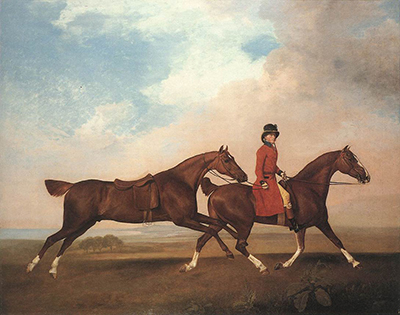The superb and confident use of colour is the first thing that strikes the observer of George Stubbs' painting William Anderson with Two Saddle Horses.
Against a misty downland landscape with the sea in the distance, a groom riding a magnificent chestnut hunter leads an equally gorgeous saddle horse, one of the thoroughbred breed whose emergence in the 18th century was one of the glories of the age. William Anderson was groom to the future George IV when he was still Prince of Wales. Part of Anderson's duty was to bring along a fresh horse for the Prince while he was out riding. Looking directly at the artist as though at a camera, the groom is smartly turned out, with fashionable yellow breeches and a long coat in the scarlet colour that would become known as "hunting pink".
The colours of horse and groom perfectly compliment the Turneresque sky and yellow-greens of the turf. The entire painting is a cleverly coded reminder of the popularity of racing, with elements including the downland background (The Downs being a popular location for racing from the days of Charles II onwards), smooth turf beneath the horses' shod feet, and the eager thoroughbred stretching into a canter alongside the trotting hunter.
The horses are very similar in colour, but entirely different in form and function. The Roman-nosed hunter has a blaze and four white legs, while the fine legs of the horse he leads convey the speed and and length of stride of the thoroughbred, created by complex breeding between fast native British running-horses and hobbies and imported "Oriental" stallions.
Speed is also conveyed in the dangling stirrups of the thoroughbred. Usually the metal irons of the stirrups would be run up to the top of the leathers for safety purposes, but clearly the Prince wants to change horses as quickly as possible, not even waiting to run down the stirrups. That this is a fresh horse and not one from which he has just dismounted is clear from the horse's liveliness, its pricked ears and lack of sweat marks. Dated to 1793 and signed by the artist, William Anderson with Two Saddle Horses became part of the Royal Collection shortly after its completion. It is a vibrant example of the work of this exceptional equine and equestrian artist.




